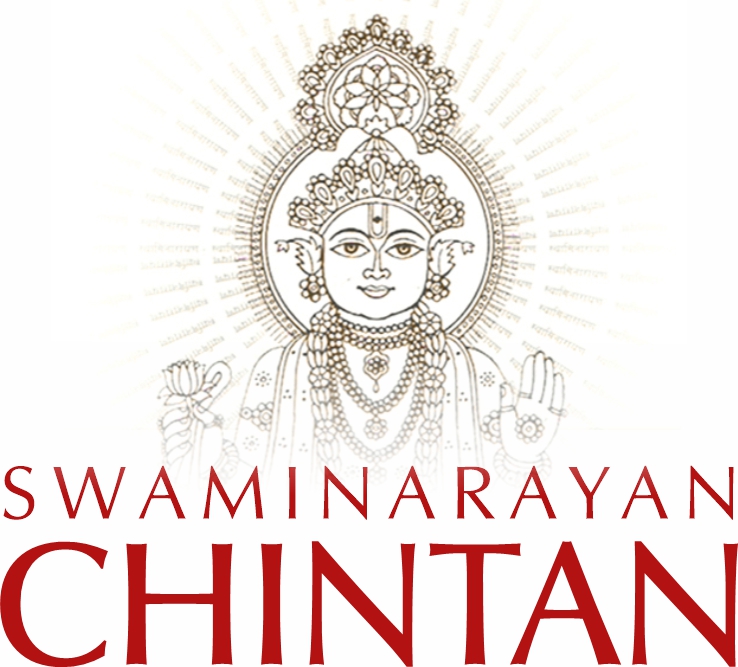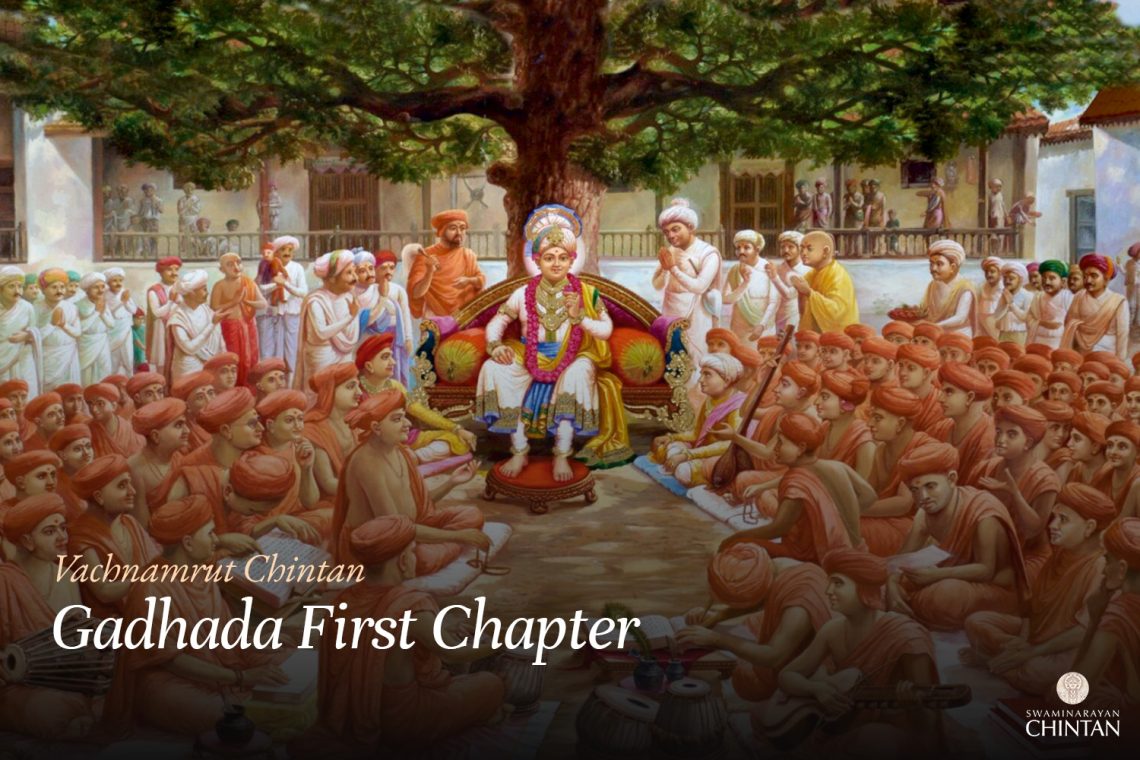Central Insights:
- Savikalp and Nirvikalpa Samādhi.
- Difference between Bhakti and Upāsnā.
Key Points:
- Spirituality affected by materialistic world or by relation to materialistic world is called Savikalp sense.
- Pure relation to Māharāj is called Nirvikalpa sense.
- Devotion towards Māharāj through nine means is called Bhakti.
- Even after being Brahmrup, keeping continuity as well as trying to maintain continuity of sevakbhāv (eagerness of devotional service) is called Upāsnā.
Explanation
In this Vachanamrut, Muktaanand Swami asked Maharaj, “O Maharaj! What is called Savikalp Samadhi and what is called Nirvikalp Samadhi?” Shriji Maharaj replied, “One whose mind is engaged in the form of God does not have inauspicious desires, even if they are in a Savikalp state; but they may have auspicious desires. Such as, feeling like being in the company of Narad, Sanaka and others, or feeling like being Shukji, or going to the ashram of Nar-Narayan and performing penance with the sages of the ashram, or going to Shvetadweep and performing penance like the Shvetmuktas. If someone has such imaginations, then he is said to be in Savikalp Samadhi. If someone doesn’t have such imaginations and is solely engrossed in the idol of God, having attained the likeness of Aksharbrahma, then he is said to be in Nirvikalp Samadhi.
In any direct or indirect manner, if there’s a connection with the world or matters related to the world’s importance, power, existence, or subjects, that’s Savikalpata. The more straightforward or indirect denial of the above matters and the connection with the divine form of the God leads one more towards Nirvikalpata. Afterward, the extent of how much more or if it becomes complete, then it is considered entirely Nirvikalp or Savikalp. The path of connection only with God is Nirvikalp. In it, as much as there’s a worldly sentiment or body-consciousness, that much it is considered Savikalp.
In the Vatos (talks) of Sadguru Gunatitanand Swami, it’s said, “Muktas (liberated souls) of Badrikashram and Shvetadweep have the strength of renunciation and detachment. Muktas of Golok and Vaikunth primarily have love. Muktas of Akshardham are Brahmarup” (First Prakran, Vat 48). So a question arises: Do the Muktas of Akshardham have renunciation and detachment? Do they have love and devotion for God? It doesn’t mean that they don’t have these qualities or there’s some deficiency. But Swami says that the main quality of Muktas from other abodes might be specific attributes, not just that; but even more than God, that might be primary. All Muktas from all abodes have all qualities and also a connection with the Supreme God, but what’s the primary focus? That matter should be taken into consideration.
Here too, Savikalp Samadhi means that while there is no worldly desire, there remains a subtle prioritization of worldly allurements over Maharaj’s divine form. In the beginning, even the Muktas (liberated souls) of Akshardham may not seem lesser than the Muktas of other divine abodes. In fact, they might even appear slightly superior. However, the defining quality of their Nirvikalp state is that, within their hearts, Maharaj’s form remains paramount, above all else.
Conversely, when Maharaj’s form is perceived as secondary compared to His divine attributes, that is what defines the Savikalp state. True Nirvikalp Samadhi occurs only when His form is the sole and absolute focus of one’s heart and consciousness.
Then, Muktaanand Swami asked, “O Maharaj! What’s the difference between devotion (bhakti) and worship (upasana)?” Shriji Maharaj replied,
Shravanam (listening to His glories), Kirtanam (singing His praises), Vishnoh Smaranam (remembering Him), Pad Sevanam (serving His feet), Archanam (worshipping), Vandanam (paying homage), Dasyam (becoming His servant), Sakhyam (becoming His friend), and Atma Nivedanam (surrendering oneself to Him).
Serving God in these nine ways is called bhakti (devotion). Upasana is considered when one’s belief in God’s form is always in its physical form. Even if one listens to scriptures that speak of God’s formless nature, they always understand God’s physical form. Even if a scripture might seem to suggest otherwise, they interpret it in the context of God’s physical form. Those with such firm beliefs are called upasakas (worshippers). In reality, in an advanced state, both are attained. But in the initial state, a slight difference appears.
In bhakti, the essence of love is primary. In Upasana the continuity and unbroken memory of a single sentiment is paramount. Devotion is of the utmost loving form, fuelled by affection. Whereas Upasana is knowledge centric. Scriptures mention ‘Vedanam-Upasanam’, which means the knowledge that serves as a means to liberation is termed Upasana. The mantras used in Upasana are primarily about invoking, while the mantras in bhakti are about offering.
In Upasana, the worshipper gets a glimpse of the worshipped.This means attributes, power, and capabilities of the God manifest in the worshipper, elevating him. “Brahmavid Brahmaiva Bhavati” means the one who knows God becomes like God. In bhakti, it’s the opposite. Forgetting God’s attributes, power, and magnificence, God becomes or wishes to become like the devotee.
In Upasana, the worshipper’s own sentiments and dedication take precedence. In Bhakti (devotion), the focus shifts entirely towards God. Still, Maharaj said that even after becoming Brahmarup (Brahm-like), if one doesn’t give up the Sevakbahv (servanthood), it’s called Upasana. Meaning, the culmination of the Swami-Servant sentiment without any boundaries is termed Upasana. This is mentioned in Vach.G.M 67. While in Vach.Loya 3, the limitless state of dedication is termed devotion (bhakti).
Glossary
| Akshardham – The eternal supreme abode of Bhagwan Swaminarayan The divine realm where Bhagwan Swaminarayan resides along with Akshar Muktas (Divine Liberated Souls) |
| Bhakti – Devotion Loving and selfless worship of God. |
| Brahmarup – Oneness with Brahm The realization of one’s eternal nature as divine and distinct from the material world. |
| Golok – The divine abode of Bhagwan Krishna |
| Kirtan – Singing praises of God |
| Nirvikalp Samadhi – A state of perfect absorption or concentration where the mind is undisturbed It is a state of meditation where the individual’s mind is fully absorbed in the object of meditation, without any distractions, and free from worldly attachments. |
| Sevakbhav – Attitude of servent The mindset of humility and service toward God and His devotees. |
| Shravanam – Listening to the glories of God |
| Shvetadweep – A divine realm where liberated souls reside |
| Upasana – Worship and devotion The practice of deep meditation and attachment to Bhagwan. |
| Vedanam-Upasanam – Knowledgecentric worship |
| Vishnoh Smaranam – Remembering God |

